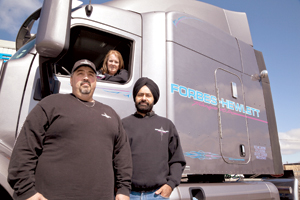Driver-Friendly Dispatching

This story appears in the May 9 print edition of iTECH, a supplement to Transport Topics.
Driver pay is a key factor in attracting and retaining drivers, but fleets said just offering a competitive per-mile rate is no longer enough. Carriers also must ensure they’re keeping drivers on the road with the right load at the right time to maximize drivers’ available hours.
Fleets said they’re turning to software to improve their planning, monitor drivers’ hours and alert customers if drivers are running ahead of or behind schedule, which can reduce dwell time.
“The myth is that if you’re paying drivers higher rates, it is going to keep them happy and keep them there. The fact of the matter is, if you don’t drive, you’re not getting paid,” said Scott Vanselous, executive vice president of marketing and strategy for TMW Systems, a provider of transportation management software.
Interstate Distributor Co., a truckload carrier based in Tacoma, Washington, uses several software programs to help planners and dispatchers make better business decisions.
BEST OF MAY iTECH: More stories, columns
“Every minute matters now,” said Paul Simmons, the company’s chief operating officer. “Anything we can do to enable our drivers to safely drive more hours is what we want to do.”
Interstate Distributor ranks No. 70 on the Transport Topics Top 100 list of the largest for-hire carriers in the United States and Canada.
Kimberley Daigle, director of human resources for Birmingham, Alabama-based P&S Transportation, said drivers expect things to run smoothly, which requires technology that runs behind the scenes.
“It is all about being able to focus on that driver and make sure the driver is getting the loads they need,” she said.
Interstate Distributor and P&S Transportation use products from McLeod Software to track real-time updates on a driver’s location, available hours and estimated pickup and delivery times.
Daigle said that before assigning drivers, dispatchers can look at McLeod’s driver feasibility tool.
“It will tell me where you are, how many hours you have at the point of pickup and the likelihood you’d be able to make that pickup or delivery based on available hours of service,” she said.
Forbes-Hewlett Transport Inc., a less-than-truckload carrier based in Brampton, Ontario, uses technology from Trans Plus Systems Corp. to help give drivers more miles and keep them happy.
“Retaining drivers always goes back to better communication,” said Nick Moschella, the fleet’s vice president of operations. “Does the software do that? Absolutely.”
Warning customers about delays, for example, allows them to make adjustments.
“Because we have a visual of where all the drivers are, we can quickly adjust things,” Moschella said. “Several years ago, they would have turned the load away and said, ‘You’re late. Come back tomorrow.’ ”
The software also can help carriers bill for detention time, which Moschella said is drivers’ No. 1 pet peeve because it steals their available driving hours and their pay.
“If drivers go to a pickup and it isn’t ready and they have to wait for five or six hours, they’re not getting paid,” he said.
Chris Manhire, general manager of Trans Plus, said, “In the end, drivers just want to get home safely, on time and get paid accurately for their work.”
Super T Transport, a refrigerated carrier based in Idaho Falls, Idaho, uses software from TMW to route and monitor drivers.
“In this world, productivity is so important for a driver’s paycheck,” company President Heath Treasure said.
In addition to accessing TMW’s software on their computer screens, dispatchers at Super T track drivers’ progress on four 55-inch monitors in the company’s “war room.” TMW’s TripAlert interactive maps show dispatchers if drivers are ahead of or behind schedule, allowing them to make adjustments for drivers to secure new delivery windows.
“When they’re a day or two ahead of schedule and just show up early, they have a 50-50 chance of getting unloaded, but if we know ahead of time, we can make arrangements way sooner than we used to be able to do,” preventing drivers from wasting time waiting for an appointment window to open up, Treasure said.
Utilizing the software also has allowed Super T to increase its on-time rate to about 98%, from the low 90s, Treasure said.
“The minute the computer system does its calculation, it takes into consideration the driver logbook, their route and their appointment time,” he said. “The response time to act and react to problems is much, much quicker.”
Mark Cubine, vice president of marketing at McLeod, also said carriers can sometimes avoid a late delivery or service failure simply by securing a new appointment time window when a driver has been delayed.
Margaret Hogg, owner of J.G. Drapeau, a carrier based in Rexdale, Ontario, increases productivity and improves load planning by using several software programs, including Trans Plus.
“The dispatcher can go and look at a driver and know exactly how many hours he can drive and how to dispatch them to a pickup or delivery,” she said.
J.G. Drapeau also uses its technology to eliminate miscommunication, which, in turn, improves efficiency and makes life easier for drivers.
“The drivers aren’t frustrated and the dispatchers aren’t frustrated,” Hogg said.
Dispatchers also can use software to plan and assign loads before drivers have completed their current trips, getting them back on the road faster.
Decker Truck Line automatically sends drivers information for their next load as soon as they are empty.
“They don’t have to sit and wait for information or call into dispatch,” said Jennifer Brim, director of training and development for the Fort Dodge, Iowa-based carrier.
Decker uses McLeod software to track drivers’ detention time and automatically calculate the detention rate it has agreed upon with customers. The main benefit is ensuring that drivers are paid for their time, Brim said.
Debra Phillips, director of marketing for MercuryGate International Inc., said the company’s software gives dispatchers visibility to the status of drivers and equipment, allowing them to dispatch drivers when equipment is available and a route plan has been established.
“This results in less downtime for a driver who is waiting to be dispatched,” she said.
Because equipment needs to be moving for drivers to make money, increasing vehicle uptime is important, too. MercuryGate offers automated management of equipment service and maintenance, so both drivers and equipment are more productive due to fewer breakdowns, Phillips said.
Bhushan Veerapaneni, vice president of operations for Paradox Software Consulting, a logistics-planning software provider, said the company’s technology creates tightly built routes and uses scheduling algorithms that enable drivers to deliver more stops per mile.
“Depending on how early they have the visibility into their order, they can do the planning on a daily or weekly basis,” he said.
Damon Langley, director of solution delivery for TMW, suggests carriers have a load ready for a driver at least two hours before he or she is empty. When setting appointments, it also is important to have on-time service, which allows the driver to move on and make more money.
“If you’re not managing that, he may arrive and wait several hours to get unloaded,” he said.
When scheduling, carriers should examine how much time is truly necessary. Many carriers waste drivers’ time by setting appointment times that are too long, Langley said.
Federal regulations and business requirements can make it challenging to properly forecast a driver’s availability without the right technology, said David McKinney, a vice president at TMW.
“Drivers have activities they have to perform before they’re available for another load. You have to model all of that in the context of [Department of Transportation] regulations,” he said. “If you determine the driver has a few hours at the end of his day, you can use him rather than laying him over.”
Reducing how often carriers have to request information from drivers also can minimize driver frustration.
Because TMW’s software tracks drivers and their locations, dispatchers don’t have to reach out for updates, McKinney said.
Manhire, of Trans Plus, added that automatic instructions and updates sent to drivers can ease stress and increase productivity.
McLeod enables fleets to share information with drivers via a mobile app and web portal.
MercuryGate provides mobile interfaces for call checks and status updates via mobile devices.
“This makes it easier for drivers to get load information and update fleet managers regarding hours worked or other details,” Phillips said, adding that managers can automatically send updated information to drivers if there are any changes in routes, saving time. ³




